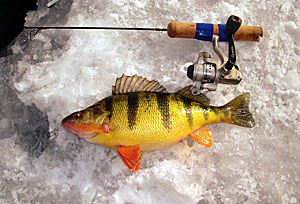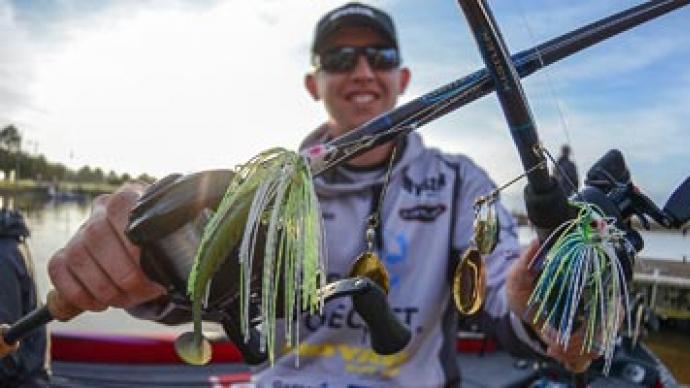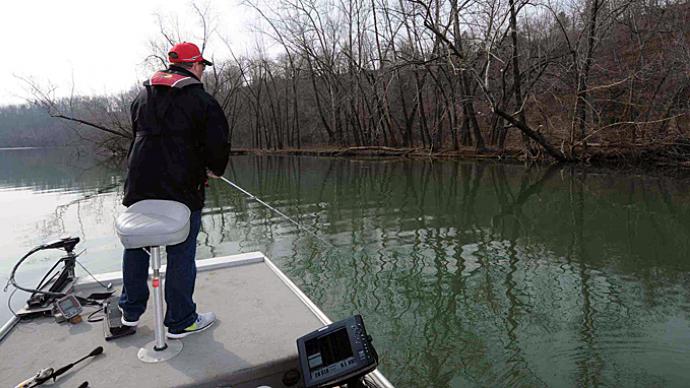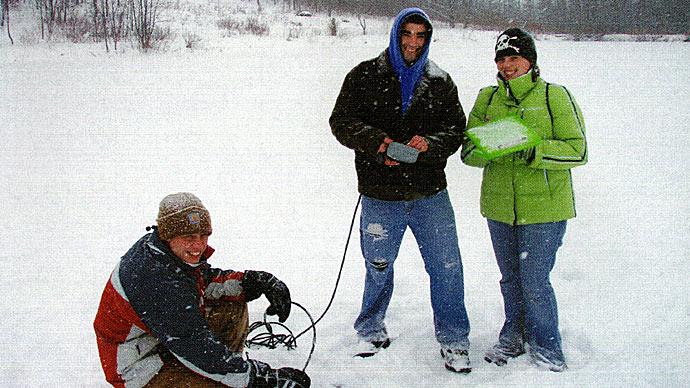
As I sit in my warm, comfy easy chair in the living room on a cold January day my thoughts often turn to what is happening under the ice in my northern upstate New York pond. Winter sets up some patterns with the physical properties of water that you should be aware of. Fish respond to these changes, so let's take a look at a few and dissect them a bit.
In the summertime, if your pond is relatively shallow and its location is windy, it is probably uniformly mixed from top to bottom by the wind. If you have a deep pond, a layer of warm water is likely at top and the coldest water is near the bottom. In large lakes, this warm layer will move with the wind and become thicker on the downwind side of the lake, allowing the cool water to come closer to the surface on the upwind side. On a grand scale, this thickening and thinning of warm layers in the stratified Pacific Ocean is a major part of the El Nino/La Nina effect!
In winter, the opposite temperature situation sets up; under ice, water in ponds is inversely stratified. The least dense, coldest water is at the top in the form of ice (32°F) and the warmest, most dense water (around 39-40°F) sits at the bottom. Inverse stratification affects fish distribution. Fish are cold blooded, meaning they conform to the temperature of their watery environment. In my experience, most fish linger near the bottom in the warmest water in the pond during winter. In fact, some fish stake their lives on the warmer bottom temperatures. In lakes and ponds with alewife or other pelagic fish, like gizzard shad, it is important these fish are able to find a warm water refuge in the winter. This usually means these fish migrate to the very deepest, warmest water in the pond or lake. If you ice fish for lake trout, (like I do) find the very deepest water in the lake. That is where the baitfish are, and consequently, that is where trout will be found. In deep northern lakes which do not freeze, the wind has access to the lake all winter and mixes the lake from top to bottom to a frigid temperature of 34- 35°F. Brrrr....Some baitfish often die when the lake has not frozen and a blistering winter wind kicks up.
For warmwater fish, like largemouth bass, winter is truly a time of slow down. Most bass move much less, don't feed often, nor do they grow well when water temperatures fall into the 40-50°F range. Now, that said, I have caught plenty of largemouth bass through the ice, meaning that they are active, and they do feed.

However, think of winter time feeding habits as a maintenance (or maybe even less than maintenance) diet. When I hook a largemouth bass through the ice, I am generally fishing for panfish. They'll hit some small jig and are fun to catch but are fairly lethargic. My students and I often look at scales of northern bass to see how bass and other fish have grown throughout their lifetimes. Fish scales grow proportionate to body length. Generally, the fish (and its scales) grow faster in summer and hardly at all in the winter. The slow growth in winter and then increasing growth each spring lays down an annular ring similar to that observed when you count the rings of a tree. In some cases, especially with warmwater fish, the scale may grow so slowly that the environment the fish is in may wear away the scale faster than the scale grows. This is a period of time in winter when the fish may lose weight or may be under severe environmental stress (like low dissolved oxygen under the ice). Want to raise trophy largemouth bass in the North over 10 pounds? Eliminate winter. My experience with bass under ice is that they tend not to feed on the typical fishy prey items that require large amounts of effort to chase down and subdue. They tend to focus more on small food items, like scuds, midges and large plankton. I have iced some very impressive largemouth on very small ice jigs.
For a cold water predator like a salmon or a trout winter may be a time of feast instead of famine. Why? Well, cold water fish prefer cold water and are generally active under the ice, assuming all other environmental conditions (like dissolved oxygen) are good. Also, cold water fish may do better in winter because their habitat may spatially overlap with the forage. What does that mean? Think about the average northeast trout pond for a minute.. .deep, spring fed, and stocked with trout and bait. During most of the year (especially summer!) trout are at the bottom in the coldest water while the baitfish (generally liking warm water) are near the surface or feeding in the shallows. So, through a good portion of the year trout are spatially separated from their forage. In the winter, baitfish prefers the warmer, deeper water near the bottom and.. .drumroll, please... so do the trout! Eureka! It is highly likely that trout stocked in northern ponds will actually utilize the forage base in your pond BETTER in winter than any other time.

This can mean a period of reprieve from stress which trout normally encounter during summer. It also means trout may grow best during winter and may also be very catchable. You can catch them on a faster, larger presentation when ice fishing, like jigging with a medium sized minnow. I spend more days fishing for trout in winter than I do the rest of the year combined. There is no finer fare for the Thanksgiving or Christmas dinner table than a nice smoked trout!
What about light? Clear ice has virtually the same transparency as water. So, if your ice is clear (which is rare) then the ice will transmit a good deal of incident light. More likely, though, ice is opaque, milky and piled with snow, further reducing incident light. Most fish do not like bright light. In fact, many fish prefer dim light to live in and to feed. I have seen an entire tank of yellow perch go off feed for an entire day when someone came into the room and turned on a light switch. So, light equals bad, right? Not necessarily. Light is necessary for photosynthesis. Under ice, photosynthesis is the only pathway available to put dissolved oxygen back in the water because diffusion from the atmosphere is next to impossible. If you have a shallow, productive pond where winter oxygen levels are a problem, and winterkill a possibility, bright sunshine is your friend. You may have the most active fish during periods of intense sunshine on a cold winter day. I have witnessed many limits of perch caught in shallow lakes in a period of minutes after sun breaks out of the clouds in late winter. Fortunately, I have the luxury of ice fishing with a dissolved oxygen meter once in a while and can see the changes in the oxygen levels. Some under-ice D.O. levels are frighteningly low! One pond I fish routinely had a D.O. below 3ppm in late winter (fish like it over 5ppm!). During this time the fish are barely hanging on. A sunny day and the accompanying bump in D.O. of only .5ppm will activate perch and bluegill and you will have a day of great fishing.
If your pond is deep and productive, the deepest water (while the warmest) maybe oxygen starved and dead in the winter. This causes fish to move out of the warm, deep water into a layer of colder but higher D.O. water. This colder, shallower habitat may not be prime for fish activity but may be necessary for the fish to survive. Crappie are a bit of an exception (aren't they always?). Crappies I observe under the ice are on the bottom during the day and suspend at night. I often catch them on the ice at night with a lantern in my shelter a few feet below the ice. Crappies tend to stay in the same niche that they occupy in the summer, and I catch them on small jigs and minnows suspended in wide-open water.

It's hard to plan your pond management strategy around the weather, but it can be done. If you have a pond prone to low dissolved oxygen and is in danger of winterkill, you need light to penetrate the ice to spark photosynthesis. How do you clear the ice? Plow (or shovel) the snow off. If you want to go one step further, aerate a section of the pond. Or, you can make the ice clearer by pumping water on top of the ice with a sump pump. If your pond is inviting to skaters and you do this, make sure you use safety precautions to label unsafe areas!
Is winter the big slowdown? Yes, for some species like largemouth bass, where they move away from their traditional habitats and foods, for warmer deeper waters. Winter is not necessarily a slowdown for trout and other cold water fishes where they also frequent deeper waters, mingling with forage. This may be a time when trout experience their best growth.
Just don't let winter slow YOU down.
Mark Cornwell is a fisheries professor at SUNY-Cobleskill in Cobleskill, New York. His passion is raising walleye and the I.Q. of fisheries students in the Northeast. Reach him at CORNWEMD@Cobleskill.edu.



